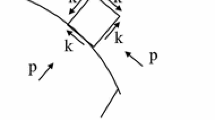Abstract
The maximum-friction surface is a source of singular solution behaviour for several rate-independent plasticity models. Solutions based on conventional viscoplastic models do not show such behaviour. For a class of materials, there is a range of temperatures and/or strain rates where a necessity of the consideration of rate effects depends on the area of application of the final result. Hence, the same material under the same conditions can be represented by either rate-independent or rate-dependent models. In this case, a reasonable requirement is that viscous effects should not be very significant and, in particular, the qualitative behaviour of viscoplastic solutions should be similar to that of solutions based on rate-independent models. The present paper deals with this issue by means of the solution for simultaneous shearing and expansion of a hollow cylinder under plane-strain deformation. One of the goals of the paper is to show that there is a class of viscoplastic models satisfying the requirement formulated. The other goal is to find an asymptotic representation of the solution in the vicinity of the maximum-friction surface and compare it with the rigid perfectly plastic solution.
Similar content being viewed by others
References
Alexandrov S, Richmond O (2000) Frictional effects in the modified Couette flow of solids. In: Pietrzyk M, Kusiak J, Majta J, Hartley P, Pillinger I (eds) 8th international conference on metal forming, Cracow, September 2000. Balkema, Rotterdam, pp 723–728
Spencer AJM (1964) A theory of the kinematics of ideal soils under plane strain conditions. J Mech Phys Solids 12: 337–351. doi:10.1016/0022-5096(64)90029-8
Alexandrov S, Lyamina E (2002) Singular solutions for plane plastic flow of pressure-dependent materials. Dokl Phys 47(4): 308–311. doi:10.1134/1.1477887
Alexandrov S (2005) Singular solutions in an axisymmetric flow of a medium obeying the double shear model. J Appl Mech Tech Phys 46(5): 766–771
Alexandrov S (2003) Comparison of double-shearing and coaxial models of pressure-dependent plastic flow at frictional boundaries. Trans ASME J Appl Mech 70(2): 212–219
Alexandrov S, Lyamina E (2005) Qualitative distinctions in the solutions based on the plasticity theories with Mohr-Coulomb yield criterion. J Appl Mech Tech Phys 46(6): 883–890. doi:10.1007/s10808-005-0148-8
Alexandrov S, Harris D (2006) Comparison of solution behaviour for three models of pressure-dependent plasticity: a simple analytical example. Int J Mech Sci 48(7): 750–762. doi:10.1016/j.ijmecsci.2006.01.009
Alexandrov S, Goldstein R (2007) Plastic flow in a conical channel: qualitative features of the solutions under different yield conditions. J Appl Math Mech 71(1): 111–119. doi:10.1016/j.jappmathmech.2007.03.004
Harris D, Grekova EF (2005) A hyperbolic well-posed model for the flow of granular materials. J Eng Math 52: 107–135
Alexandrov S, Alexandrova N (2000) On the maximum friction law in viscoplasticity. Mech Time-Depend Mater 4(1): 99–104. doi:10.1023/A:1009851621518
Oldroyd JG (1947) Two-dimensional plastic flow of a Bingham solid: a plastic boundary-layer theory for slow motion. Proc Camb Philos Soc 43: 383–395. doi:10.1017/S0305004100023616
Alexandrov S, Mishuris G (2007) Viscoplasticity with a saturation stress: distinguished features of the model. Arch Appl Mech 77(1): 35–47. doi:10.1007/s00419-006-0078-9
Alexandrov S, Richmond O (2001) Singular plastic flow fields near surfaces of maximum friction stress. Int J Non-linear Mech 36(1): 1–11. doi:10.1016/S0020-7462(99)00075-X
Lyamina E, Alexandrov S, Grabco D et al (2007) An approach to prediction of evolution of material properties in the vicinity of frictional interfaces in metal forming. Key Eng Mater 345(346): 741–744. doi:10.4028/0-87849-440-5.741
Aukrust T, LaZghab S (2000) Thin shear boundary layers in flow of hot aluminium. Int J Plast 16(1): 59–71. doi:10.1016/S0749-6419(99)00047-9
Voce E (1948) The relationship between stress and strain for homogeneous deformation. J Inst Metals 74: 537–562
Adams MJ, Briscoe BJ, Corfield GM et al (1997) An analysis of the plane-strain compression of viscous materials. Trans ASME J Appl Mech 64: 420–424
Miszuris G, Mishuris W, Alexandrov S (2008) Solution asymptotics near maximum friction surfaces in plane strain block compression: various viscoplastic laws with a saturation stress. In: Jeulin D, Forest S (eds) Proceeding of 11th international symposium on continuum models and discrete systems Paris (FRANCE). ParisTech Les Presses, pp 225–231
Aleksandrov SE, Baranova ID, Mishuris G (2008) Compression of a viscoplastic layer between rough parallel plates. Mech Solids 43(6): 863–869. doi:10.3103/S0025654408060046
Sinczak J, Kusiak J, Lapkowski W et al (1992) The influence of deformation conditions on the flow of strain rate sensitive materials. J Mater Process Technol 34: 219–224. doi:10.1016/0924-0136(92)90110-E
Webster WD Jr (1982) Development of a friction element for metal forming analysis. Trans ASME J Eng Ind 104: 253–256
Atkins AG (1969) Consequences of high strain rates in cold working. J Inst Metals 97: 289–298
Author information
Authors and Affiliations
Corresponding author
Rights and permissions
About this article
Cite this article
Alexandrov, S., Mishuris, G. Qualitative behaviour of viscoplastic solutions in the vicinity of maximum-friction surfaces. J Eng Math 65, 143–156 (2009). https://doi.org/10.1007/s10665-009-9277-z
Received:
Accepted:
Published:
Issue Date:
DOI: https://doi.org/10.1007/s10665-009-9277-z




